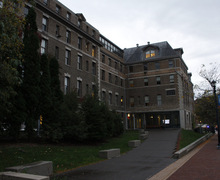‘Babylon’s loud audacious style makes it Damien Chazelle’s most intriguing work
Lindy Truitt | Assistant Illustration Editor
In ‘Babylon,’ stardom is not as glorious as it may seem.
Get the latest Syracuse news delivered right to your inbox.
Subscribe to our newsletter here.
“Babylon,” Damien Chazelle’s new three-hour epic illustrating Hollywood’s transition to sound, pulses with the enthusiasm of a director obsessed with the art of moviemaking. It is rare for an artist to honor their influences as literally as Chazelle does in this film, which remixes bits and pieces of movies ranging from “Singin’ in the Rain” to “Tron.”
The film is both a tribute to the magic of Hollywood movies and a condemnation of the ruthless business practices used to bring them to life. It’s messy and chaotic, but in a way that feels deeply personal, like Chazelle is grappling with his own insecurities about the industry and has not come to a clear conclusion. This conflict between product and method, communicated with audacious style, makes “Babylon” his most interesting work to date.
While the director’s 2016 musical “La La Land” romanticized the film industry and the dreamers who inhabit it, “Babylon” reimagines Hollywood as a lurid death trap from which there is no escape. Its heroes arrive in Los Angeles from small towns across the world to lay down their lives and identities in pursuit of stardom. Their success or failure is at the mercy of rapidly shifting trends and cold studio executives who rarely appear on screen but whose presence is always felt.
The movie begins with an extravagant party thrown by one of those executives, Don Wallach (Jeff Garlin). This impressive sequence blends original visual flair with overt references to Hollywood classics like “Morocco.” The party excites and frightens all at once, as Chazelle can cut from joyful exuberance to grotesque horror at any moment. It is the most overwhelming visual work he has ever created, full of tracking shots that navigate through a golden-hued maze of partygoers, musicians and eventually an elephant.
Here the audience meets Nellie LaRoy (Margot Robbie), an aspiring actress who sneaks into the event with the help of Manny Torres (Diego Calva), a film-obsessed young man who works odd jobs for Wallach while he looks for an on-set gig. The two quickly become friends and form a bond based on their shared ambition.
As the night goes on, both newcomers get their big break. In a morbid turn of events, an actress overdoses at the party, and Wallach’s producers choose Nellie to replace her in a small role shooting the next day. Manny becomes a trusted assistant to the silent film star Jack Conrad (Brad Pitt) after he chauffeurs the drunk actor back to his mansion.
If these circumstances seem comically arbitrary, it’s by design. The decision-makers in Chazelle’s Hollywood are only concerned with immediate utility. Manny is competent and quick on his feet, so Conrad keeps him around. Nellie is selected at random by a producer who doesn’t even know her name. These are the origin stories of assets, not artists.
Manny and Nellie are reunited on set in the morning, where Conrad and Nellie are both performing in films produced by Wallach. Here, Chazelle depicts silent film sets like the Wild West, with misbehaving stars and hundreds of extras brought in from Skid Row in exchange for a free lunch. There is no need for quiet on these sets because no audio is recorded. Dozens of movies are shot at the same time, inches away from one another, and cast and crew alike are allowed to be as rowdy as they please.
By the end of the day, one extra is dead, an ambulance has been stolen, and Nellie has caught the studio’s attention with a scene-stealing performance so magnetic that her director refuses to stop rolling even after a nearby set catches fire.
Chazelle is critical of the conditions on these sets and makes sure to show how brutally the production company treats the workers who keep everything running. But he also clearly reveres the works of art that these spontaneous production environments were capable of producing.
His admiration shines through when the commotion fades away and the audience is presented with black-and-white film images of Nellie’s performance. Although her passionate work only amounts to a single scene in Wallach’s movie, “Babylon” finds deep value in the moment being immortalized on film at all.
Once the use of sound becomes popular in Hollywood, stuffy indoor stages quickly replace the free-wheeling outdoor sets of the silent era. Nellie can no longer experiment with each take— she instead has to deliver written monologues and stand still on the stage so the microphones can hear her clearly. Jack Conrad, once an internationally beloved star, becomes a laughing stock because of his untrained speaking voice, thus proving how sound broadened the potential of the medium but left behind a generation of artists in the process.
“Babylon” is undoubtedly indulgent and sometimes can feel overstuffed, especially as the movie enters its third hour. But the plot moves so engagingly between set pieces that the energy never has a chance to die down.
Though box office returns suggest that “Babylon,” like the silent films it mythologizes, is part of a dying breed, Chazelle should be commended for using a large budget to engage in earnest, original, large-scale filmmaking. The final montage he uses to end the movie, an astonishing rapid-fire assault of images taken from the past hundred-plus years of film history accompanied by Justin Hurwitz’s award-winning musical score, is one of the most evocative pieces of moviemaking in recent memory.

Published on January 16, 2023 at 10:29 pm






